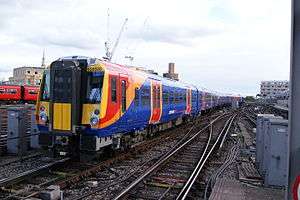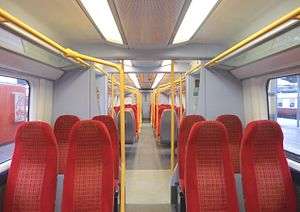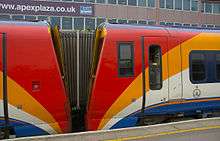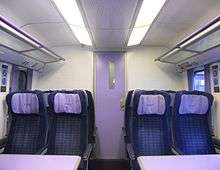British Rail Class 458
| British Rail Class 458 Juniper | |
|---|---|
 South West Trains 458526 at London Waterloo in 2015 | |
 The interior of a refurbished Class 458/5 | |
| In service | 2000 – Current |
| Manufacturer | Alstom |
| Built at | Washwood Heath |
| Family name | Juniper |
| Replaced | |
| Constructed | 1998–2002 |
| Refurbishment |
Refreshed: 2008-2010 Refurbished: 2013-2016 |
| Number built | 30 trainsets (As original 458/0) |
| Formation |
4/5 cars per trainset 458/0 (As built): DMCO-PTSO-TSO-DMCO 458/5 (As rebuilt): DMSO-TSOL-TSOL-MSO-DMSO |
| Fleet numbers |
458001–458030 (re-numbering to:458501-458536) |
| Operator(s) | South Western Railway |
| Specifications | |
| Car length |
DMCO 21.01 m (68.9 ft) MSO/PTSO 19.94 m (65.4 ft) |
| Width | 2.80 m (9 ft 2 in) |
| Height | 3.77 m (12 ft 4 in) |
| Maximum speed |
458/0 100 mph (161 km/h) 458/5 75 mph (121 km/h) |
| Weight | 164.3 t (161.7 long tons; 181.1 short tons) |
| Electric system(s) | 750 V DC Third rail |
| Braking system(s) | Air, Regenerative |
| Track gauge | 1,435 mm (4 ft 8 1⁄2 in) standard gauge |
The British Rail Class 458 is an electric multiple-unit passenger train built by Alstom at Washwood Heath between 1998 and 2002 for South West Trains. They were the first new fleet of trains to be delivered following the privatisation of British Rail.[1]
The fleet of 30 four-car trains was ordered in 1997, with the first train delivered in October 1998.[2] The trains entered passenger service between 2000 and 2003 and are maintained at Wimbledon depot.[3] They form part of Alstom's Juniper family of trains, which also includes Classes 334 and 460.[4]
Between 2013 and 2016, they were merged with the mechanically similar Class 460 fleet and reconfigured into 36 five-cars units, designated Class 458/5, to improve capacity.[5] The trains are now used by South Western Railway.[6]
History

Introduction to service
A tender for a fleet of thirty of these four-car trains was placed by South West Trains (SWT) in November 1996 to create extra capacity and to replace some of the ageing Class 411 (4CEP) units, with a contract being signed between Alstom, the winner of the bid; Porterbrook, the rolling stock operating company and South West Trains, who the trains would be leased to.[2] It was reported that the tender also took place to ease industry and political concern regarding the owner of South West Trains, Stagecoach Group's purchase of Porterbrook. Deliveries of these units began in 1998.[7][8]
The units, numbered 458001-030, were delivered in SWT's mainline livery of mainly white, with a blue band, and red/orange 'swish' at cab ends. They are the only Juniper EMUs to feature end gangways. Each four car unit was formed from two outer driving motors, an intermediate trailer, and an intermediate motor. The maximum speed when built was 100 miles per hour (161 km/h).[7]
The class initially suffered from major technical problems, such as leaky roofs and failing electronics.[9] The gangways were designed on the presumption that the trains would be semi permanently coupled, with coupling and uncoupling taking thirty minutes, however in existing operations trains were regularly coupled and uncoupled which had to be abandoned following the introduction of the new units.[10] The protracted introduction led to South West Trains' decision to buy trains from the competing Siemens Desiro range in April 2001 for the replacement of the rest of the slam door fleet.[10][11]
Withdrawal from service
In 2004, when the full fleet was in service, reliability was so poor that SWT planned to return them to the leasing company and replace them with new Class 450 Desiro trains.[9] At that time, the trains only managed an average of 4,300 miles (6,900 km) between failures, compared with an average of 21,000 miles (34,000 km) for a Class 450 Desiro and 50,000 miles (80,000 km) for the previous slam-door trains.[9]
In September 2005, two units (458001 and 458002) were transferred to Gatwick Express, but returned later that year.[12] By 2006, the reliability of the trains combined with the introduction of the new, more reliable British Rail Class 450 fleet meant that the trains had been withdrawn from regular service, with eight kept on standby.[13] In July 2006, the Department for Transport refused to grant an further exemption from the Rail Vehicle Accessibility Regulations, resulting in modifications to the passenger information system being made, with new wider LEDs fitted within the existing housing.[13]
Return to service
As part of Stagecoach's bid for the replacement South Western franchise, it was planned that the class 442 stock would leave the franchise, with class 444 stock internally cascaded to replace the units, and that the class 458s would return to service to maintain the overall fleet size.[13] It was speculated that this was due to Porterbrook being unable to find any other rail operators willing to lease the class 458 trains (the trains having been rented to South West Trains on a pay per use basis following the expiry of the original lease),[7] and halving the rental costs.[13] The class 458s slowly re-entered service with the 23 units having re-entered service in January, sufficient for the last class 442 to be withdrawn on 24 January 2007.[13] By February 2007, reliability had improved with the class 458 fleet managing 17,800 miles between per 5 minute delays caused by failures, in contrast to expectations that the units' reliability would further suffer following their lengthy period in storage.[13]
Refresh and reliability improvements
In 2008–2010 Bournemouth Train Care Depot 'refreshed' these EMUs.[14] The 'refresh' included adding CCTV, new seats and tables in first class, an internal repaint, and Rail Vehicle Accessibility Regulations (RVAR) compliant lavatory, information display panels and door lights.[14]
In May 2010 two trains were in service with regenerative braking, the trial was a success with the rest of the fleet fitted by summer 2011.[15] By the end of 2012, the fleet had achieved an average of 106,049 miles (170,669 km) between failures, becoming the most reliable fleet in Britain and the first fleet to achieve a 6-figure rating.[16] As a result, the fleet was awarded a Modern Railways Golden Spanner award in the New Generation EMU category on 23 November 2012.[17]
Lengthening to form Class 458/5
South West Trains and Porterbrook merged the Class 458 trains with the mechanically similar Class 460 (former Gatwick Express) trains, largely unused since September 2012, to form 5 coach trains.[18] Six of the eight Class 460 trains lost three carriages in the process, leaving them as 5-car trains that were also reconfigured as class 458/5 trains. The other two trains lost 6 carriages each, with the remaining 4 vehicles (driving/luggage vehicles) being decommissioned for spares. This £42m scheme was devised by Porterbrook, owner of both fleets.[19] The "new" 5-car sets will be designated Class 458/5 and coupled together to form 10-car trains to provide extra peak-time capacity on suburban services into Waterloo from the Hounslow, Weybridge (via Staines) and Windsor lines, using one of the five disused Waterloo International platforms, starting in 2014.[20][21] The project was of SWT's aspiration to become a "10-car railway".[19]
Porterbrook signed the deal with SWT in January 2012.[22] The work was carried out by Wabtec, Doncaster and Brush Traction, Loughborough (Drive vehicles) on behalf of the original builder Alstom. The first trains were scheduled to arrive in May 2013, but due to protracted delivery, the work was slower than anticipated, and as a result the first trains did not enter service until March 2014.[18][21]
As part of the re-build the driving vehicles were modified to include a more conventional design of gangway. The couplers are sourced from Voith.[23] New Train Management System software was installed to improve reliability. Internally, a light refurbishment included reconfiguring the seating layout to provide more standing room for passengers.[19] Traction units were re-geared from 100 mph (161 km/h), not required on the services for which the trains were to be used, to 75 mph (121 km/h) maximum to avoid overheating. The sets were painted in the SWT blue livery as on the Class 450 units. Automatic Selective Door Opening (ASDO) was installed for use at a few suburban stations where it is not practical to lengthen platforms.[19]
The first two of the 5-car sets were delivered in October 2013 and entered passenger service in March 2014.[23][24]
Two 458/5 coupled units were involved in an incident at Windsor & Eton Riverside on 30 January 2015. The Rail Accident Investigation Branch determined this was caused by the power cables not being secured correctly when they were reconnected during the rebuild.[25]
The project was completed on 30 March 2016, when the final converted unit, 458516, returned to South West Trains.[13]
Fleet details
| Class | Operator | No. Built | Year Built | Year converted | Cars per Set | Unit nos. | Notes |
|---|---|---|---|---|---|---|---|
| Class 458/5 | South Western Railway | 30 (as 4 car) | 1998-2002 | 2013-2016 | 5 | 458501-458530 | Previously 4 car 458/0 with a former Class 460 TSOL vehicle. |
| 6 | 458531-458536 | Converted from Class 460. |
Gallery
 Pre conversion Class 458/0 No. 458030 at Clapham Junction
Pre conversion Class 458/0 No. 458030 at Clapham Junction The interior of First Class cabin
The interior of First Class cabin The original interior of Standard Class accommodation
The original interior of Standard Class accommodation
References
- ↑ "Old trains...new homes?". www.railmagazine.com. Rail Magazine. Archived from the original on 2017-11-01. Retrieved 2018-06-07.
Now, just a few months later, Porterbrook needs to find a home for the fleet, which had been the first delivered since privatisation in 1998
- 1 2 Lindop, Peter (4 April 2000). "458- A Fast Track Development?". Locomotive & Carriage Institution. Archived from the original on 2017-03-05. Retrieved 7 June 2018.
- ↑ "Golden Spanners Awards 2015 | Modern Railways". Modern Railways. 3 December 2015. Archived from the original on 2018-06-07. Retrieved 2018-06-07.
- ↑ "Railtex 2000 review". Railway Gazette. DVV Media International. 1 Jan 2001. Archived from the original on 2018-06-07. Retrieved 2018-06-07.
- ↑ Llewelyn, Hugh (2016). EMUs A History. Amberley Publishing Limited. ISBN 9781445649832.
- ↑ "First train arrives late at South Western Railway launch". www.railmagazine.com. 5 September 2017. Archived from the original on 2017-09-09. Retrieved 7 June 2018.
- 1 2 3 The Fall and Rise of South West Trains' 458 Units Archived 2017-10-23 at the Wayback Machine. – Southern Electric Group. Retrieved 26 December 2010.
- ↑ "Alstom's first Juniper unit delivered to South West Trains". RAIL. No. 344. EMAP Apex Publications. 18 November – 1 December 1998. p. 7. ISSN 0953-4563. OCLC 49953699.
- 1 2 3 "Train firm to replace new fleet". BBC News. 12 January 2004. Archived from the original on 13 March 2007. Retrieved 2 July 2008.
A commuter rail company is to replace 30 of its newest fleet of trains because they keep breaking down.
- 1 2 "Fall and Rise of the 458s". extra.southernelectric.org.uk. Archived from the original on 2017-10-23. Retrieved 2018-06-07.
- ↑ "Class 450". www.semgonline.com. Archived from the original on 2017-11-23. Retrieved 2018-06-07.
- ↑ Gatwick Express 458s Archived 2016-03-04 at the Wayback Machine. – Southern Electric Group. Retrieved 26 December 2010.
- 1 2 3 4 5 6 7 "SWT rolling stock upgrade completed". Rail Business Intelligence (513): 6. 7 July 2016.
- 1 2 Class 458s being "refreshed" at Bournemouth T&RSMD Archived 2016-04-14 at the Wayback Machine. – Southern Electric Group. Retrieved 21 May 2011.
- ↑ "South West Trains invests £2.2m in regenerative braking system to drive greener trains" (Press release). South West Trains. 4 May 2010. Archived from the original on 19 January 2013. Retrieved 6 January 2012.
- ↑ Ford, Roger (January 2013). "First six-figure winner tops all-round improvement". Modern Railways. London. p. 64.
- ↑ "Class 458 triumphs at Spanners | Modern Railways". Modern Railways. 26 November 2012. Retrieved 2018-06-07.
- 1 2 Clinnick, Richard (25 January 2012). "Class 460 driving vehicles made redundant". Rail. Peterborough. p. 28.
- 1 2 3 4 Walmsley, Ian (February 2012). "Junipers United: Darth Vader goes suburban". Modern Railways. London. p. 40.
- ↑ "£42m for longer Waterloo trains". Rail. Peterborough. 11 January 2012. p. 7.
- 1 2 "London commuters to benefit from longer peak time trains" (Press release). South West Trains. 23 December 2011. Archived from the original on 17 January 2012. Retrieved 30 December 2011.
- ↑ "Porterbrook signs agreement for the future of Class 458s" (Press release). Porterbrook. 3 January 2012. Archived from the original on 19 February 2012.
- 1 2 "Improving Your Railway - Longer Trains". South West Trains. Archived from the original on 9 November 2013. Retrieved 11 March 2014.
- ↑ "South West Trains prepares to introduce longer trains". Railway Gazette. London. 23 October 2013. Archived from the original on 1 February 2014.
- ↑ "Report 18/2015: Arcing and fire at Windsor & Eton Riverside". Rail Accident Investigation Branch. Archived from the original on 1 February 2016. Retrieved 25 January 2016.
Further reading
| Wikimedia Commons has media related to British Rail Class 458. |


